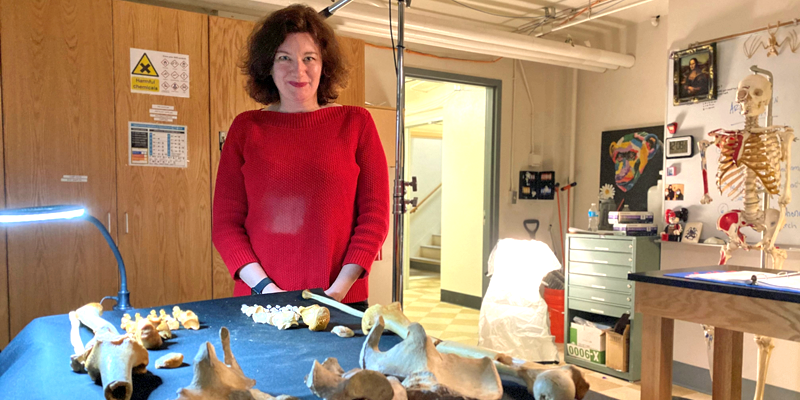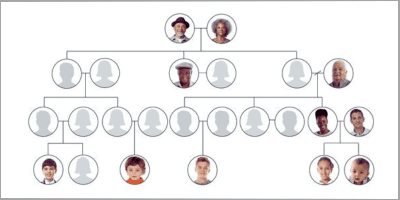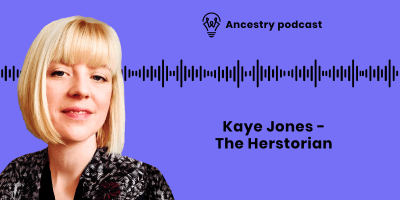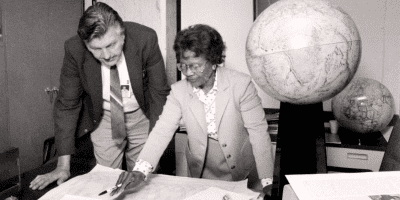Professor Turi King is a distinguished geneticist, acclaimed author and a prominent figure in the field of genetics research. Known for her groundbreaking work in DNA analysis and genealogy, Professor King’s expertise has revolutionised our understanding of human ancestry. Turi is co-presenter of the BBC Two series, DNA Family Secrets, as she uncovers how DNA has revolutionised genealogy and forensics, helping us trace long-lost family members, catch criminals and make remarkable historical discoveries.
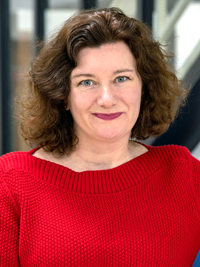
“I love it when I love it when you’re explaining something and you can see that penny drop moment. It’s so rewarding when the audience takes away a greater understanding of the background to what we’re doing.”
From Canada to Cambridge, and then Leicester
I grew up in Canada and I went to the University of British Columbia for a couple of years before I then came over to England on holiday. I was working as an archaeologist as well as a waitress. I then applied to Cambridge on a bit of a whim because if I went back to finish my degree in Canada it’d be two years and if I stayed in the UK, it’d be three.
I secured a place at Cambridge, studying archaeology and anthropology, before I became interested in how you can use genetics to answer questions in history and archaeology, so I was when I was asking around my tutors all said: “Go to Leicester”, as the man who invented DNA fingerprinting, Professor Sir Alec Jeffreys, was based there.
I did my master’s degree and then my PhD at the University of Leicester, and Alec Jeffries was on my PhD panel so I felt incredibly fortunate to be able to work with such a famous and well-respected scientist. Then I did my postdoc [fellowship] and the Richard III project came along. Alec was retiring so I was asked if I would like to work on it. They knew I had this unusual background in archaeology and genetics, so I led on how to excavate under ‘clean’ conditions, because it’s ancient DNA. I then led on the genetics and the identification of the remains and ancient DNA has become one of my specialisms.
Alongside this, I now present DNA Family Secrets with Stacey Dooley on the BBC, so I combine being an academic alongside public engagement and a media career on the side.
Joining the Milner Centre for Evolution in April
I’m thrilled to be joining the Milner Centre for Evolution at the University of Bath in April. The reason it’s so appealing to me is because the Centre has three main aims. The first is to ask the big, evolutionary questions. Frankly, you can’t do genetics without exploring evolution. The second aim is to see if you can find applications for that, so clinical applications, for example. And then the third aim is around public engagement. I’ve been doing public engagement in science for over 20 years now, and that was because of my PhD.
For my PhD, I explored the link between British hereditary surnames, which are passed down through the generations, along with a piece of our DNA known as the Y chromosome. The Y chromosome has on it the gene for maleness, essentially. So, British surnames come down through the male line (you get them from your dad, and from his dad and so on back through time and the Y chromosome is a piece of DNA which also comes down through the male line).
So, the question I sought to answer was: “Are all men alive today with the same surname related to each other?”
Take, David Attenborough, for example. Are all male Attenboroughs from around the country all related to each other because they’re all descended from an original Mr Attenborough who lived several hundred years ago? If so, they all have the same surname, but they should also all have identical or near identical Y chromosome types. And so that was basically my PhD.
And, oh my goodness, it opened the floodgates because I would have loads of people who were doing their family history (genealogy) saying: “I’ve got this particular surname and I think I’m related to this other guy with the same surname, so could you do the DNA analysis for me?” And I started to get asked to give talks to family history societies, but also scientific conferences and things like that. So, I quickly learned how to make the science accessible. How should I explain this to a layperson? How does this work? And I became incredibly interested in it and excited by it, so it just went from there.
And that’s the third main aim of the Milner Centre. So, not only do I get to continue my research, but I’m going to be helping the researchers there to take their research out into the community and more widely. It’s perfect for me.
Ways that genetic methods can help advance research in fields including forensics, history, and archaeology
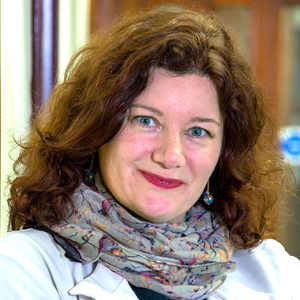
In my talks, one of the things I discuss is genetics being able to use DNA to identify an individual. The first thing looked at was disease. Scientists wanted to be able to trace disease in families, and then very quickly, the first thing they realised was that you could use it for forensic purposes.
Before this, DNA fingerprinting was used in an immigration case where a woman had been living in the UK with her three children and one of her sons had been back in Ghana, come back into the UK but the authorities didn’t believe it was her son, but DNA fingerprinting proved that he was.
So, DNA gets used for forensic cases, immigration cases, and then obviously family history. I was using a version of DNA fingerprinting in my PhD, to identify Y chromosome types, so it was being used for genealogy purposes then.
It’s all coming full circle now because there are now standard methods of examining our DNA, which allows us to look for genetic variants that might be associated with disease, but it also allows us to identify individuals, lots of little genetic variants that you have across the genome. That then allows us to look for how people are related to one another.
We’re now using genetic testing in forensics, even in cold cases, the most famous of which is the Golden State Killer case from California in the late 70s and early 80s. It started with burglaries and it progressed to rapes and murders, over a hundred in total, but then it suddenly stopped in the mid-1980s. People have been trying to solve this cold case for years. There had been DNA from some of the crime scenes and they tried the usual DNA fingerprinting but they didn’t get any hits, so eventually they decided to conduct genetic testing and upload it to a database.
What that gives you is people who are related to the perpetrator, so the question is how are they related? The DNA gives you hints, and then what you have to do then is take those relatives and build a family tree. In this case, all these relatives went back to a set of great, great, great grandparents.
So, the perpetrator was descended from this couple, so then you have to work your way down: “Who are all the descendants of this couple?” Then you can go: “Well, OK, so it’s not the women, we know that. This guy’s too old, this guy’s too young, this guy’s not in the right place.” The technology can now predict what somebody’s going his eye colour is, so they were then able to go to the database of driver’s licences and home in on this individual.
They then went and staked out outside his house, and he put his trash out one day, and inside was a tissue, which they went and grabbed, did the DNA on, and it was him. It was genetic genealogy that led them to him.
Unlocking the secrets of DNA
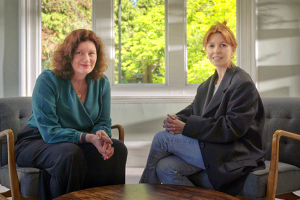
This is what I do for DNA Family Secrets when I’m trying to find somebody’s parent, I’m looking at the relatives, and I’m trying to build these family trees, and then realising: “OK, so the person’s father must have descended from this couple” and you start to work your way down.
So, from originally trying to understand the inheritance of disease they realised you can use it to identify individuals and that gives you forensics, which then started getting used for genealogy. Then they came up with this new way of looking at our DNA, which was for medicine, which then got used for genetic genealogy, which is now coming back to forensics.
Then of course you’ve got the Richard III project where we were able to use DNA to identify the remains of Richard III. So that was a case of using a piece of DNA known as mitochondrial DNA, the mother’s line, which Richard inherited from his mother, Cecily, who passed it down to his eldest sister, Anne, who had a daughter, who had a daughter, who had two daughters and then down through the generations.
So, we had a gentleman called Michael Ibsen and then a lady called Wendy Duldig, and they were descended from those two daughters all those generations ago. Fourteenth cousins, twice removed through the female line. So, I was looking at their DNA and seeing if it matched the skeleton, and it did!
I’m also extremely lucky because I started off in archaeology and I was attending lectures in Cambridge. DNA fingerprinting had been invented relatively recently, and it was starting to be applied to forensic cases, but it was the Romanov case that got me interested. Tsar Nicholas, his wife and family were killed during the Bolshevik Revolution. Experts were using archaeology, osteology and genetics to identify their remains. This lecture is what decided me that this was what I wanted to do.
I am asked to advise on television dramas when they want to understand how you use genetic genealogy to trace individuals, or how you can use DNA and genetic analysis to answer particular questions. I’m very keen to make sure it’s done properly so I’m not shouting at the television! I love it because it’s genetics in popular culture.
I love doing shows like DNA Family Secrets because it’s important having women out there, working on stuff that people can see. Being visible is hugely important as, to quote the well-known saying by Marian Wright Edelman: “You can’t be what you can’t see”.
Importance of diversity of thought, not only in science but in history and archaeology
For me, interdisciplinarity in science, history and archaeology is so important. For years and years, we’ve all been in our little silos. It was “I’m a geneticist” and “I’m an archaeologist” and you didn’t talk to each other. The Richard III project was an excellent example of everyone working collaboratively because no one person could have done it on their own. It took people from all different disciplines all bringing their expertise to the table. It’s one of those things where the total is greater than the sum of its parts.
The other thing I liked about it was that most of the science was led by women. So, the osteology was led by a woman called Dr Jo Appleby. Forensics was led by a woman called Professor Sarah Hainsworth. The stable isotope analysis was led by people like Professor Jane Evans. This creates better, more holistic projects if you combine expertise across different disciplines because it brings different bits of information to the project.
Diversity of thought in terms of different people’s backgrounds is vital. In my native Canada and North America more broadly they’re now doing a lot of work with ancient remains from First Nations people it is critical to have people from these backgrounds as part of the project because it’s their ancestry.
That’s been a huge problem in the past where unfortunately geneticists have gone in and taken samples, and they’ve done the work without including the communities or they don’t include scientists from those communities. They need to be part of it, if not leading it.
Seeing the penny drop moment
My passion for outreach also started with my PhD, and I realised it was something which people were extremely interested in, but didn’t quite understand. I love it when you’re explaining something and you can see that penny drop moment. It’s so rewarding when the audience takes away a greater understanding of the background of what we’re doing.
I had been going around countries and I’d been giving talks around the world already on the work that I had been doing, but the Richard III project just kicked that off and on steroids.
I believe it’s part of our duty as scientists to communicate about the work that we’re doing. Part of that comes from the fact that we are often funded by charities and organisations with charitable objectives. I’ve become even more passionate about it because people often think of scientists as beavering away quietly in their labs in isolation, when this isn’t the case.
The other thing is that science is quite a creative process, because when you’re working on things, you have to think around problems and be like: “OK, this isn’t working. I wonder if this will work.” There are ups and downs with it too. People often don’t realise that about it though, so I’m passionate about communicating about science to help people better understand the work that we’re doing.
Advice for people seeking to learn about their family history
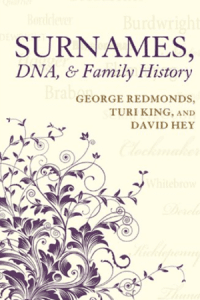
The next thing you can do is to start going through documentary evidence, so start looking for birth and marriage and death records. If you want to give it a big jump start, go and get your DNA tested with somebody like Ancestry or 23andMe. This is coming from the geneticist in me because very, very quickly you’re going to get lots and lots of people who are your genetic matches, so they are your relatives.
What you need to do is then build the family trees to work out how they’re related. That’s actually the tough bit and takes longer, but that’s what I would recommend. If you go and talk to your relatives immediately and then go and take a DNA test you’ve got to combine the genetics with all of the historical evidence, all the documentary evidence, but it’s great fun and you can completely go down all kinds of rabbit holes.
How the Womanthology community can engage
If you’d like to keep up with the work I’m doing, I’ve got a web page, a YouTube channel and a podcast. I’m also on X and Instagram.
Coming up next
I’m looking forward to starting at the Milner Centre for Evolution. I think that’s going to be really good fun and it couldn’t be more perfect because I get to do research and they’re also building me my own clean lab, which I’ve never had before. Up until now, I’ve always had to travel to one in another location but I’m getting a clean lab at Bath, so that’s going to be amazing, not only to allow me to get going on my work on that side, but also the public engagement side of things and working with the community in Bath, Bristol and the surrounding area.
That’s going to be one of the best things because I’ve been embedded in the community in Leicester so if I’ve needed something I could email the mayor or I can get a hold of the relevant people within the city. I’m very excited to be able to replicate that in Bath.
Main photo © Martin Evanson
All other photos, unless stated, are © Carl Vivian

